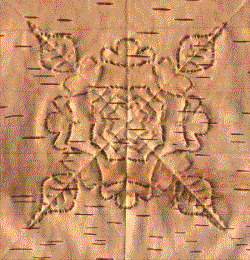My slogan click to edit me

Other Uses of Boreal Plants
The use of the Boreal forest by humans extends farther than medicinal and nutritional purposes. Aboriginal people have used and continue to use many native Boreal plants as materials to construct everything from shelters to snowshoes, including canoes, toys, and even works of art. In the past, these uses served as necessity rather than recreation, where being able to build things like snowshoes, toboggans, or canoes was essential to the nomadic lifestyle of many groups and Aboriginal cultures in the Boreal region. As people of these cultures have became more modernized and assimilated with current North American culture, many of these skills and traditions have been lost, as the interest of younger people to learn such practical skills from older people in the community is continually dwindling. In many cases, these skills and traditions are now put to use through making gifts and souvenirs to be sold in Canadian cities, especially ones with strong ties to their aboriginal history, such as Vancouver.
Balsam fir (Abies balsamea)
- wood used for canoe paddles and frame
- temporary shelters
Tamarack (Larix laricina)
- wood used for making toboggans
- snowshoe frames, drum frames
- canoe paddles
- roots can be used as stitching to join sheets of birch bark
in the making of birch bark canoes and baskets
-wood and bark may be used to smoke fish and hides, respectively
White Spruce (Picea glauca)
- canoe frames and paddles
- floats for fishing nets
- arrows
- snowshoe frames
- bowls and other food containers
- roots used to stitch birch bark canoes and baskets
- branches used to make wind barriers, meat drying racks and caches, tepees, and lean-tos
- melted pitch is good adhesive for birch bark baskets and canoes, and to waterproof twine and ropes made of animal rawhide
- bark used for shingles, mats, and flooring in tents canoes
- boughs used for bedding and floors in tents
Black Spruce (Picea mariana)
- logs used for deadfall traps for wolverine, mink, and marten
- saplings used for spring-pole snares, toss-pole snares, and dragging-pole snare for beaver, porcupine, hare, and lynx
- branches are boiled in water, and the water rubbed on traps to remove scent of humans
- used for frames or as boards for the stretching and cleaning of hide
- saplings used as the frame and ribs of spruce bark canoes
- logs and boughs used for lean-tos, tepee frames, and tent frames
- snowshoe frames
- boughs used to make carpet
- charcoal from spruce fire used for tattooing
Jack Pine (Pinus banksiana)
- logs used for making cabins
- branches used for windbreaks
- roots used for making coiled baskets
- has been used to make fish hooks, specifically from the pine knot
- Planks be used to make Chipewyan toboggans
- used to make fishnet floats, as well as in boat planking.
- arrow shafts



Paper birch (Betula papyrifera)
- Bark used for baskets, bowls, canoes, sleds, food platters, tepee covers, writing and drawing material
- wood used for snowshoe frames, toboggans, sleds, arrows, drum frames, wooden nails, drum frames, handles for whips and axes, hammers, and eating utensils
- The bark is also used in the art of birch biting, practiced primarily by the Algonkian linguistic group
OTHER BOREAL PLANTS:
Sphagnum moss sanitary napkins, diapers, toilet paper, mattress stuffing, as well as a material to clean floors
Balsam poplar (Populus balsamifera) plates, bowls, buds used in trap lures
Trembling aspen (Populus tremuloides) canoe paddles, cooking sticks, tepee poles
- combined with caribou grease, the ashes are used to make soap
Common Juniper (Juniperus communis) Cones used to make brown dye
Mountain alder, green alder (Alnus spp.) bark used for red-brown dye, “mosquito smudge” carving pipes, ladles, bowls etc.

Canada Goldenrod (Solidago Canadensis) insects that reside in stem galls used for bait for fishing
Fireweed (Family Onagraceae) fibre for making thread
Greenland dicranum moss (Dicranum groenlandicum) soaked and combined with caribou fat to create candles
Cow parsnip (Family Apiaceae) root mixed with other things as bear bait for traps, hollow stalks of plant used as make-shift snorkels
Tinder fungus (Fomes fomentarius):
- used to make jewellery, figures for graves
For more information on the Beothuk people of Newfoundland and how they used plants of the boreal forest, click on the birch bark bowl!
References:
Karst, A. 2010. Conservation Value of the North American Boreal Forest from an Ethnobotanical Perspective. Canadian Boreal Initiative, David Suzuki Foundation and Boreal Songbird Initiative; Ottawa, ON; Vancouver, BC; Seattle, WA.
Marles, R. J., Clavelle, C., Monteleone, L., Tays, N., Burns, D. 2000. Aboriginal plant use in Canada’s northwestern boreal forest. Canadian Forestry Service.
BOREAL @ MEMORIAL
